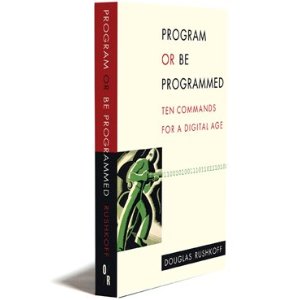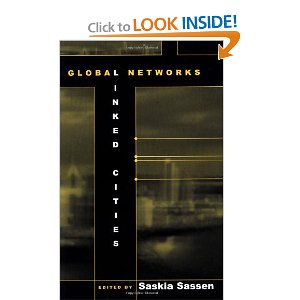
Oliver L. Reiser
Quick overview and appreciation by the chapter:

Oliver L. Reiser
Quick overview and appreciation by the chapter:

Lisa Gansky (Author)
5.0 out of 5 stars How and why a new business model has created a “perfect storm” of opportunities
November 10, 2010
By Robert Morris (Dallas, Texas) – See all my reviews
A Mesh enterprise (as opposed to a Mesh company) consists of everyone directly or indirectly associated with the design, production, marketing, sales, distribution, and servicing. It relies on advanced web and mobile data networks to obtain or create whatever information is needed (e.g. demographics of consumers, market trends and patterns, as well as the nature, extent, and frequency of usage. Also, it makes effective use of word-of-mouth and social network channels to “get the word out” about offers, news, and recommendations.
Continue reading “Review (Guest): the mesh–why the future of business is sharing”

Douglas Rushkoff
I. TIME Do Not Be “Always On”
II. PLACE Live in Person
III. CHOICE You May Always Choose “None of the Above”
IV. COMPLEXITY You Are Never Completely Right
V. SCALE One Size Does Not Fit All
VI. IDENTITY Be Yourself
VII. SOCIAL Do Not Sell Your Friends
VIII. FACT Tell the Truth
IX. OPENNESS Share, Don’t Steal
X. PURPOSE Program or Be Programmed
5.0 out of 5 stars Re-Humanizing Our Future
December 29, 2010
Brent Finnegan (Harrisonburg, VA, US) – See all my reviews
I haven't read Rushkoff's other books (although I might go back and read Life Inc: How Corporatism Conquered the World, and How We Can Take It Back).
Program or be Programmed is a quick read. I read it on the Kindle my wife got me for Christmas. The irony of reading a book about the pitfalls and possibilities of technology we don't fully understand on a device I don't fully understand was not lost on me.
I would describe this as an “Internet philosophy book” that might fit on the bookshelf somewhere between Neal Stephenson's In the Beginning…was the Command Line and Jeff Jarvis' What Would Google Do? But I found Program to be even more thoughtful and succinct than those books.
Quote from the book: “Instead of learning about our technology, we opt for a world in which our technology learns about us.”
Continue reading “Review (Guest): Program or be Programmed–Ten Commands for a Digital Age”

Jesse Eisenberg
![]() Six Star Special–The Essence of the Emerging Era
Six Star Special–The Essence of the Emerging Era
January 27, 2011
I was very glad to have a chance to see this movie on an airplane, and it was everything others had led me to believe. For myself, it captured the essence of what Peter Drucker calls the mono-maniac. I found the over-all blend of academic banality, personal eccentricities and genius, inter-personal egos and intentions, and the final financial settlements to be totally engrossing.
In many ways I consider Facebook to be the anti-thesis of Google; the first is earnest and personal despite some warts, and a self-made network–the second is secretive, mathematical, went corporate, and lost its soul in the process–as well as its direction.

John J. Mearsheimer
![]() Cornerstone, Not the Whole Building
Cornerstone, Not the Whole Building
January 2, 2011
By no stretch should this book be dismissed as a three. While I might normally have gone with a four, I am settling on five for balance and because the author not only covers an extraordinarily important topic in a sensible measured way, but his endnotes are another book all by themselves–I recommend all readers start there.
Where the author falls short is in lacking a strategic analytic construct for measuring the true costs of lying in blood, treasure, and spirit. He tends to ascribe pure motives to leaders (for example, not at all confronting the raw fact that Dick Cheney committed 23 documented impeachable acts (see my review of Vice: Dick Cheney and the Hijacking of the American Presidency for the itemization) and Dick Cheney also led the telling of 935 documented lies best covered by TruthDig but also in Weapons of Mass Deception: The Uses of Propaganda in Bush's War on Iraq.
The book disconnects grand strategy (global engagement) from domestic prosperity in a manner I find disconcerting, and while the author is most able in documenting the costs to a democracy of lies to the public, I do not see nor feel the deeper reality: lies destroy the Commonwealth. Lies allow a two-party tyranny to sell out to the Arabs (not just the Israelis), to Wall Street–lies permit the mortgage clearinghouse fraud, the derivatives fraud, and the Federal Reserve fraud on the one hand, while also fooling the public into a national security policy that is clinically insane, catastrophically costly, and ultimately a self-inflicted wound that could be fatal.
Continue reading “Review: Why Leaders Lie–The Truth About Lying in International Politics”

Saskia Sassen (Editor)
4.0 out of 5 stars Almost on the Mark, October 15, 2010
By Retired Reader (New Mexico) – See all my reviews
This book, edited by urban sociologist Saskia Sassen, takes a unique look at the phenomenon of globalization in terms of inter-connected cities held together by commercial ties, telecommunications, and commonality of interests. The book provides some important insights about the role of cities in globalization. Sassen and her colleagues appear to view globalization as creating a networked type of organization with cities serving as nodes and international telecommunication systems serving as connectors. This is a remarkable concept.
Yet the book is seriously flawed by the use of improper or imprecise terminology by its contributors. Terms like `networks', `nodes', and `architecture' are thrown about without much regard for what those terms actually represent. Their constant misuse in this book makes for very confusing reading and obscures the very valid points that the book strives to make.
Although the book was published in 2002 none of its contributors apparently have ever heard of the misnamed Global Telecommunications Network. This is the generic title for a compilation of independently owned and operated international telecommunication (carrier) networks. These networks incorporate domestic and international carriers each of which consists of transmission lines (largely fiber optic cable and satellite) coupled with relays, switching centers and various sub-stations. Nor do any of the authors understand the content carried by these networks is provided by various public and private service providers such as Internet Service Providers (ISPs) and SWIFT (a private banking service provider). Since the inter-connectivity between cities (and nations) pretty much depends on access to the Global Network, as does international commerce, this is a serious error of omission.
Also there are far too many statements in this book that simply make no sense in terms of telecommunications infrastructures. For example, Stephan Graham informs the reader that “the public, national telecommunication regimes that were ostensibly about throwing electronic networks universally across national space economies are being materially and institutionally splintered” and being replaced by “global strategies.” One can only guess that Graham is trying to say that national telecommunication networks are being absorbed into the Global Network. The seeming inability to use precise terminology leaves the reader confused.
To its credit the book becomes stronger when it moves from the theoretical to concrete examples in Part II (Cross Border Regions) and Part III (Network Nodes) with studies of specific cities. Yet here too one runs into puzzling use of terminology such as in the Beirut study by Huybrechts which he sub-titled “Building Regional Circuits.” `Circuits' in this context is meaningless when what he is referring to is re-establishing Beirut's import-export role as the principal international port in the regional economy.
In the end Sassen appears to have developed a valid way to describe globalization, but failed to establish either a standardized terminology or a valid model of a networked type of organization. As a result this book makes an unnecessarily weak case for globalization as best represented as a networked type of structural organization.


Phi Beta Iota: two reviews are provided, one from the blogsphere (Tip of the Hat to Pierre Levy at LinkedIn, and one from Amazon. If not obvious, this new trend in organizational learning assures that “secret” organizations will get dumber and dumber as time goes by.
Authors: Tony Bingham and Marcia Connor
I (Bill Ives) was very pleased to receive a review copy of The New Social Learning by Tony Bingham and Marcia Conner. Tony is President and Chief Executive Officer of the American Society for Training & Development (ASTD). Marcia is a Partner at Altimeter Group, founder of the Twitter chat #lrnchat, and writes the Fast Company column “Learn at All Levels.”
Getting a chance to read this timely work excited me for several reasons. First, I began my consulting career in the learning space in the 80s and have remained convinced of its importance for accelerating business performance. I presented at several ASTD session during this period. Second, Marcia was also a colleague of mine at Pistachio Consulting where we did some projects together. I had a chance to review an earlier version of one of the chapters of this book. But most importantly, it is the first book I have seen to help organizations understand and harness the huge workplace learning potential of social media and enterprise 2.0.